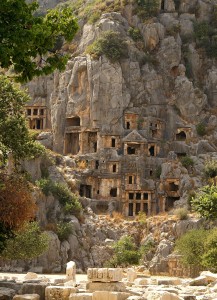In Leviticus 16, we read of the sacrificial offering on the Day of Atonement. Among other sacrifices, the high priest would take two goats for atonement of the people. One, he would kill as blood sacrifice on the altar, and the other, he would transfer the sins of the people onto the goat by confession and the laying on of his hands. This action of transferring the bloodguilt onto the “other” is where we got the concept of “scapegoat.”
But that is not the most fascinating piece of this puzzle. For in verses 8–10 and 26, the priest is told to send the goat “away into the wilderness to Azazel” (v. 10)! You read that right: Azazel.
Leviticus 16:7-10
Then he shall take the two goats and set them before the Lord at the entrance of the tent of meeting. And Aaron shall cast lots over the two goats, one lot for the Lord and the other lot for Azazel. And Aaron shall present the goat on which the lot fell for the Lord and use it as a sin offering, but the goat on which the lot fell for Azazel shall be presented alive before the Lord to make atonement over it, that it may be sent away into the wilderness to Azazel.
 The name Azazel is not explained anywhere in the Old Testament, but we’ve heard that name before in the book of Enoch.[1] Azazel was one of the lead Watchers who led the rebellion of 200 Watchers to mate with the daughters of men. And that Watcher was considered bound in the desert of Dudael.
The name Azazel is not explained anywhere in the Old Testament, but we’ve heard that name before in the book of Enoch.[1] Azazel was one of the lead Watchers who led the rebellion of 200 Watchers to mate with the daughters of men. And that Watcher was considered bound in the desert of Dudael.
The natural question arises whether this is the same sacrifice to goat demons that Yahweh condemns in the very next chapter in Leviticus:
Leviticus 17:7
So they shall no more sacrifice their sacrifices to goat demons, after whom they whore.
But a closer look dispels such concerns. Read on.
The first goat was “for Yahweh” and the second “for Azazel” (v. 8). But whereas the first goat was a sacrifice, the second was not. As commentator Jacob Milgrom claims, “In pre-Israelite practice [Azazel] was surely a true demon, perhaps a satyr, who ruled in the wilderness—in the Priestly ritual he is no longer a personality but just a name, designating the place to which impurities and sins are banished.”[2]
Milgrom then explains that in the ancient world, purgation and elimination rites went together. The sending out of the scapegoat to Azazel in the wilderness was a way of banishing evil to its place of origin which was described as the netherworld of chaos, where its malevolent powers could no longer do harm to the sender.[3] This wilderness of “tohu wabohu” or emptiness and wasteland was precisely the chaos that Yahweh pushed back to establish his covenantal order of the heavens and earth, so it was where all demonic entities were considered to reside.
So Azazel could very well have been considered the father or leader of the goat demons. In the book of 1Enoch, Azazel is imprisoned in an opening in the desert of Dudael (1Enoch 13:4–8). But scholar Judd Burton argues that this unknown location might very well be connected to Mount Hermon, the original home of the Watchers when they came down to the earth (1Enoch 6:6). He points out that a very important “opening” existed near Hermon in the Grotto of Pan at the site called Banias. In the Hellenistic period (200 B.C.) the Greeks established a shrine to Pan, the satyr god of nature and shepherding, that became quite influential in the worship of Pan in the Greco-Roman period.
Judd then speculates that the shrine was originally to Azazel in antediluvian days because of the close similarities between Azazel and Pan. Firstly, both deities were associated with the goat. Secondly, Pan was driven by primal sexual lusts, just as Azazel lusted after human women and led the Watchers to mate with them. Thirdly, both Pan and Azazel were adept at war craft. The victory at Marathon in 490 BC was attributed to Pan, just as the art of making weapons and waging war was attributed to Azazel. And lastly, “with regard to the mystical, Pan and Azazel are also kindred spirits. The Greeks associated Pan with divination and prophecy, and Azazel himself took an active role in revealing the mystical knowledge of heaven to humanity.”[4]
It was this cave grotto at Banias near Hermon that may be the mysterious Dudael location or the memorial to Azazel’s imprisonment. The Seirim clan of Banias in my novels Joshua Valiant and Caleb Vigilant embodies this spiritual and theological reality. And this is how I appropriated Azazel’s original binding at the flood in Noah Primeval, by having him bound in a desert called Dudael, but his final binding occurs at Mount Hermon in a later Chronicle. It was a both/and theological unity.
And if you don’t believe me, here is scholar Michael Heiser’s article on Azazel and Leviticus 16 that concurs with my basic thesis.




5 comments on “Of Myth and the Bible – Part 8: Azazel – Watcher, Goat Demon”
Interesting! Personally I felt that Azazel/Innana/Ishtar/Astarte was one of the most interesting villains in the entire saga,owing to his psychotic and flamboyant nature. Next to Mastema and Baal he/she is arguably one of the most nefarious enemies of the archangels and the Chosen Seed.
I also liked how you depicted Azazel’s two bindings although personally I found it “weird” in your stories that fallen angels can be freed after their binding. But after all this is a work of theological fiction,and the Bible is silent whether Watchers can escape their imprisonment(i suspect not). And it blew my mind away when this ancient villain supposedly gone for good,reappeared in Chronicles of the Apocalypse along with his old buddy Semyaza as Apollyon’s lackeys. But at least hes masquerading as a male god now. Ha!
The only issue i might have is that in your novel Joshua Valient about the connection of the Seirim Clan with Azazel (in Godawaverse only). Yeag i get the theological and historical connection,but how did the satyrs know about Azazel since he was still in the Ashtart persona? Some antediluvian tradition that was corrupted?
Of course she could have founded/influenced the tribe when breeding giants in Caanan,but it wasnt spelt out clearly it your book. Still I liked it when Rahab realised Ashtart was none other than Azazel from the goat like statue.
Uriel’s Camel,
Thanks for your words of appreciation!
The connection of the Seirim to Azazel would be the fact that you already mentioned: Just because one might be gone, does not mean their legends don’t live on. In fact, they would grow in legend.
Thanks for explaining. Psst! Did i leak out too many spoilers??
Nah. 🙂
Comments are closed.